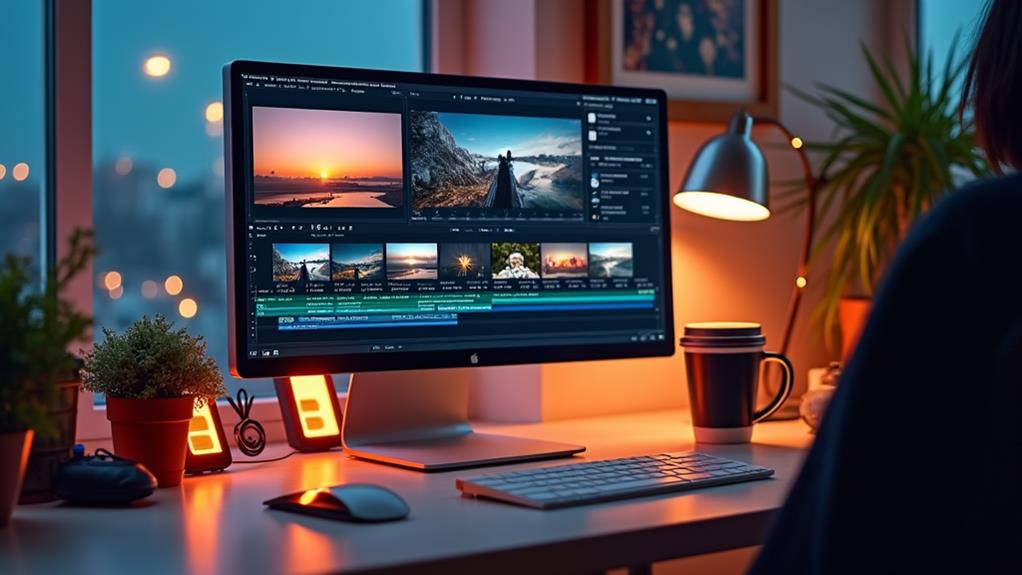Turning your blog posts into videos is a strategic way to enhance engagement and broaden your reach. Begin by selecting top-performing evergreen posts using analytics for lasting appeal. Develop a clear content strategy aligning with your goals, and craft concise scripts enriched with hooks and visual storytelling. Choose a suitable video format—explainer, listicle, or animated—to align with your audience's preferences. Focus on high-quality recording techniques and meticulous editing for a polished finish. Measure success with engagement metrics and audience feedback to refine your strategy. Discovering the intricacies of each step will empower your content transformation.
Key Takeaways
- Identify high-performing blog posts using analytics tools to select content for video adaptation.
- Define clear content goals and align them with your brand's marketing objectives for effective video production.
- Develop audience personas to tailor video content style, tone, and messaging to target viewers.
- Craft a concise video script with a strong hook, narrative flow, and a compelling call to action.
- Select appropriate video formats, such as listicles or explainer videos, for engaging visual storytelling.
Value of Repurposing Content
Repurposing content into video format consistently proves to be a strategic move for content creators aiming to broaden their audience reach and engagement. Videos are shared 1200% more than text-based content, highlighting their potential to exponentially increase audience interaction.
The transformation of existing blog posts into video not only extends the content's lifespan but also enhances content longevity by adapting to the evolving preferences of audiences. With 80% of consumers preferring video over text, this visual medium considerably boosts audience engagement, making it an essential tool in a creator's arsenal.
Moreover, integrating video content can greatly improve search engine optimization (SEO). Websites hosting video content often rank higher on search engines, thereby attracting more organic traffic. This also results in a reduction of bounce rates by 34%, as videos tend to captivate and retain viewers' attention more effectively than static text.
Additionally, repurposing evergreen blog content into video is a cost-effective strategy. It saves time and resources by avoiding the need to create new content from scratch, while maximizing return on investment. By leveraging video, creators guarantee their content remains relevant and impactful across diverse audience segments and platforms.
Selecting Top Blog Posts
Identifying the top blog posts for video adaptation is an essential step in maximizing the potential of your content strategy. It requires a thoughtful audience analysis and a thorough examination of blog performance.
Leveraging tools like Google Analytics can help pinpoint high-traffic posts with prolonged engagement durations, indicating content that resonates well with your audience. By focusing on evergreen content, you guarantee the longevity and continued relevance of your video adaptations.
Evaluating blog formats that naturally align with visual storytelling—such as how-to guides, listicles, and step-by-step processes—can greatly enhance viewer engagement. These formats allow for dynamic presentations, making them ideal for video content.
Additionally, audience feedback, such as comments, likes, and shares, can provide valuable insights into which topics generate the most interest, guiding your selection process.
When considering adaptability for video, assess how easily the core messages can translate into compelling visual and auditory narratives. This guarantees the content remains engaging and effective in its new format.
- Use Google Analytics to identify high-performing posts.
- Focus on evergreen content for lasting relevance.
- Choose formats suitable for visual storytelling.
- Collect audience feedback for informed decisions.
- Evaluate adaptability for visual and auditory elements.
Video Content Strategy
Crafting an effective video content strategy begins with clearly defining your content goals, ensuring each video serves a specific purpose within your broader marketing objectives.
Understanding your target audience is essential, as it guides the tone, style, and messaging of your video content to align with viewers' preferences.
Additionally, optimizing the video structure enhances viewer engagement and retention, ultimately leading to improved conversion rates and SEO performance.
Define Content Goals
Establishing clear content goals is the cornerstone of an effective video content strategy, serving as the guiding force that aligns video production with overarching marketing objectives. By guaranteeing content alignment with these objectives, businesses can create videos that not only captivate but also contribute meaningfully to brand awareness, lead generation, and audience engagement.
Defining measurable objectives, such as boosting video views by 30% or increasing click-through rates by 15%, provides tangible benchmarks to assess the success of the video content.
To refine your video strategy, consider the following key elements:
- Content Alignment: Ensure that video themes and messages are consistent with your brand's strategic goals and values.
- Measurable Objectives: Set specific, quantifiable targets to track progress and evaluate effectiveness.
- Strong Call to Action: Incorporate compelling CTAs to drive viewer interactions and improve conversion rates by up to 80%.
- Audience Insights: Though detailed audience analysis is essential, start by aligning content with general viewer preferences to boost engagement.
- Continuous Improvement: Regularly review analytics and feedback to adapt and refine content goals, keeping strategies relevant and impactful.
Identify Target Audience
To effectively transform blog posts into compelling video content, a deep understanding of your target audience is paramount. Audience demographics, including age, gender, and interests, are foundational elements that influence the style and tone of your video content. By analyzing this data, creators can tailor their approach to resonate more deeply with viewers.
Survey methods and feedback collection are essential in gathering insights into audience preferences, guaranteeing that the chosen video topics align seamlessly with their interests. Engagement metrics derived from analytics tools offer invaluable insights into which blog post topics have previously captivated your audience, guiding your decisions on which content should be adapted into video format.
Additionally, behavior segmentation enables a more nuanced understanding by identifying different audience groups based on their interaction patterns and preferences. This segmentation allows for the creation of tailored video content that speaks directly to these specific groups, enhancing both engagement and effectiveness.
Incorporating audience personas is another strategic approach. These personas serve as representations of your ideal viewers, helping to guide the video content creation process. By aligning content with the needs and expectations of these personas, you guarantee that your videos are not only engaging but also relevant and impactful.
Optimize Video Structure
Understanding your target audience lays the groundwork for creating video content that resonates, but the structure of the video itself can make or break its effectiveness. A well-structured video seamlessly integrates a clear beginning, middle, and end, ensuring that your key messages are communicated effectively to maintain audience engagement.
By incorporating storytelling elements, you can forge stronger emotional connections, making even complex topics more relatable and understandable. This approach enhances video pacing, keeping viewers intrigued and involved throughout.
Moreover, video pacing is essential; keeping videos between 1 to 3 minutes is ideal, as shorter videos typically boast higher retention rates. Visual aids such as graphics and animations can greatly amplify viewer comprehension, with studies showing that visuals improve message retention by up to 65%. These elements should be strategically placed to complement the narrative without overwhelming the viewer.
Consider these strategies for improving video structure:
- Begin with a compelling hook to grab attention.
- Integrate storytelling to build an emotional connection.
- Use visuals to enhance comprehension and retention.
- Maintain concise pacing to keep viewers engaged.
- End with a strong call to action to guide further engagement.
A clear structure not only facilitates effective communication but also bolsters audience engagement, ensuring your video content resonates and prompts action.
Script Development
Effective script development is pivotal in transforming blog posts into engaging videos, demanding a focus on crafting concise and captivating scripts.
By enhancing storytelling techniques, creators can guarantee their content resonates with the audience, while streamlining script refinement helps maintain clarity and coherence.
Tailoring the script to align with viewer preferences not only maximizes engagement but also amplifies the overall impact of the video.
Crafting Effective Video Scripts
Crafting an effective video script, while rooted in the art of clear communication, demands a strategic approach to engage audiences right from the start. Achieving script clarity is essential; begin by summarizing key points from the blog post into concise statements, guaranteeing each sentence remains under 120 characters. This not only maintains audience engagement but also enhances the flow and comprehension of the content.
The initial seconds of a video are pivotal, so incorporate a compelling hook to capture attention immediately, as retention rates plummet if interest isn't piqued swiftly.
Utilizing a storyboard format can further enhance script clarity by visually aligning text with corresponding visuals and shifts. This organization guarantees a seamless narrative flow, keeping viewers engrossed throughout the video.
Additionally, end the script with a clear call to action, guiding viewers on the next steps, such as visiting the blog or subscribing for more content.
To refine the script, consider using automated tools or seeking peer feedback to guarantee the messaging aligns with the original blog post while being tailored for an auditory audience.
- Summarize key points concisely
- Use a strong hook
- Align text with visuals
- Define a clear call to action
- Review and refine the script
Enhancing Storytelling Techniques
A well-crafted video script serves as the backbone of compelling storytelling, engaging audiences by transforming information into a vivid narrative experience. To maximize audience connection, begin with a strong hook that captures attention instantly, capitalizing on the fact that 80% of consumers recall video content over text. Employ narrative techniques that guarantee a logical flow—beginning, middle, and end—to enhance retention and engagement. Relatable anecdotes can simplify complex topics, fostering emotional engagement and encouraging viewer interaction and sharing.
Incorporating visual storytelling elements like sound design and graphic elements enhances the narrative by reinforcing key messages. These components are essential for maintaining audience engagement throughout the video.
| Visual Storytelling | Emotional Engagement | Audience Connection |
|---|---|---|
| Strong Hook | Relatable Anecdotes | Logical Flow |
| Sound Design | Case Studies | Clear Structure |
| Graphic Elements | Simplified Topics | Viewer Interaction |
| Key Messages | Emotional Ties | Retention Increase |
| Concise Script | Audience Sharing | Attention Capture |
Effective script pacing is critical, with a duration ideally under two minutes, aligning with audience attention spans to prevent engagement drop-off. By integrating these storytelling techniques, you raise your video content, making it both memorable and impactful.
Streamlining Script Refinement
In the domain of script development, leveraging advanced tools such as AI-driven teleprompter features can dramatically streamline the script refinement process. Utilizing features like the magic wand capability, these tools enhance text automatically for clarity and engagement, contributing to more effective script automation.
This efficiency not only speeds up the script creation process but also guarantees that the resulting content is more engaging, potentially increasing audience engagement by up to 1200%.
A structured script format effectively conveys key messages, maintaining audience focus and comprehension throughout the video. Regularly reviewing and editing content based on audience feedback further boosts relevance, aligning with the 54% of consumers who desire more video content from brands.
To optimize delivery, scripts should remain concise and focused, ideally within 120 words per minute, to match the average viewer's attention span for online videos.
- AI-enhanced teleprompters: Streamline script editing for clarity and engagement.
- Increased viewer retention: Well-refined scripts make content easier to follow.
- Audience feedback: Essential for optimizing content relevance.
- Structured format: Guarantees clear communication of key messages.
- Concise scripting: Matches viewers' attention spans, enhancing delivery effectiveness.
Incorporating these strategies in script development can notably boost the quality and impact of your video content.
Choosing Video Formats
Selecting the right video format is essential in transforming blog posts into compelling visual content that resonates with your audience. A video format comparison reveals the strengths of each type, enabling you to make informed decisions that enhance audience engagement.
Explainer videos are perfect for delving into complex topics, offering detailed explanations and practical demonstrations that facilitate thorough understanding. This format is particularly effective for educational content that requires clarity and depth.
Listicle videos, on the other hand, excel in presenting information in a structured, visually appealing manner. Their sequential nature makes them easy to follow, ensuring that key points are highlighted and remembered.
When aiming to build authority, interviews and discussion videos serve well, as they integrate expert viewpoints, offering valuable insights that captivate viewers and establish credibility.
For topics that benefit from simplification, animated videos are an excellent choice. They distill intricate subjects into digestible visuals, improving retention and engagement.
Recording Techniques
Effective recording techniques are essential in producing high-quality videos that captivate and engage your audience. To guarantee your videos resonate with viewers, it is important to focus on both audio quality and visual composition. High-quality audio is a cornerstone of viewer retention; using a reliable microphone can greatly enhance your video's professionalism.
Equally important is visual composition, which can be achieved by implementing the rule of thirds. This technique helps in framing your shots to make them visually compelling and directs attention to your main subject.
Lighting is another key factor that influences the overall quality of your video. Natural light or softbox lights can dramatically improve the visual appeal by preventing harsh shadows.
Practicing your script delivery is also necessary, as it reduces the need for numerous retakes, guaranteeing a smoother recording process. Finally, recording in a quiet environment minimizes background noise, enhancing the viewer's experience.
- Audio quality: Invest in a high-quality microphone.
- Lighting: Use natural or softbox lighting.
- Visual composition: Apply the rule of thirds.
- Script practice: Read aloud multiple times.
- Quiet environment: Minimize background noise.
Implementing these techniques will boost your video production, making it both professional and engaging.
Video Editing Essentials
Creating compelling video content goes beyond just capturing footage; the essence lies in mastering video editing essentials. An effective editing process begins with cutting and trimming unnecessary footage to sustain a concise narrative. Studies highlight that viewer retention markedly drops after the initial few minutes, emphasizing the need for engaging content. Adding seamless shifts between scenes enhances the video's flow, rendering a polished and professional appeal.
Color grading is integral in setting the tone and mood, guaranteeing visual consistency throughout the video. Meanwhile, audio mixing plays a pivotal role in elevating the viewer's experience. Properly adjusted audio levels, coupled with background music, can profoundly impact the emotional resonance and clarity of the content, with 65% of viewers acknowledging its importance.
Incorporating relevant visuals, such as images and graphics, can increase viewer engagement by up to 94%. Additionally, utilizing subtitles and on-screen text not only boosts accessibility but also enhances engagement, with captioned videos generating 26% more views.
Here's a quick overview:
| Editing Aspect | Impact |
|---|---|
| Cutting & Trimming | Maintains concise narrative |
| Shifts | Enhances flow and professionalism |
| Color Grading | Guarantees visual consistency and tone |
| Audio Mixing | Enhances emotional impact and clarity |
Measuring Video Success
In the pursuit of creating successful video content, understanding and measuring its impact is essential. Key engagement metrics such as views, likes, shares, comments, and watch time provide a thorough view of how audiences interact with your videos and gauge their effectiveness.
Analyzing audience retention rates is vital, as it highlights segments where viewers lose interest, allowing for strategic content optimization in future projects.
Gathering audience feedback through comments and surveys offers invaluable qualitative insights into viewer preferences, revealing areas for potential enhancement. Leveraging analytics tools from platforms like YouTube and Facebook can further aid in evaluating video performance, guiding content development, and shaping promotional strategies to align with audience interests.
To refine your content approach and maximize viewer engagement, consider implementing A/B testing on varying video formats, lengths, and calls to action. This method helps identify what resonates most with your audience, enhancing conversion rates.
Here are some practical steps:
- Track key engagement metrics regularly.
- Analyze audience retention to identify drop-off points.
- Collect audience feedback through surveys and comments.
- Utilize analytics tools for performance evaluation.
- Conduct A/B testing for content optimization.
These strategies guarantee your video content achieves the desired impact and engagement.
Frequently Asked Questions
How to Convert a Blog Post to a Video?
To convert a blog post to a video, employ storytelling techniques to craft a concise script. Integrate visual elements like graphics and animations to enhance engagement, ensuring the content resonates with your audience while maintaining clarity and interest.
How to Turn a Blog Post Into a Video Script?
To turn a blog post into a video script, develop a structured outline that highlights key themes. Integrate visual storytelling techniques to enhance engagement, ensuring the script remains concise, clear, and audience-focused for effective communication within a short duration.
How to Make a Blogging Video?
Creating a blogging video requires effective visual storytelling to capture your audience's attention. Focus on concise, engaging content that highlights key points. Use visuals strategically to enhance understanding and maintain audience engagement throughout the video's duration.
How to Turn Articles Into Video?
To transform articles into videos, employ visual storytelling techniques to effectively convey your message. Focus on enhancing audience engagement by crafting a compelling script, integrating dynamic visuals, and optimizing content for diverse platforms to maximize reach and impact.
Conclusion
Repurposing blog posts into videos offers a strategic avenue for enhancing content reach and engagement. By selecting top-performing blog entries and developing a coherent video content strategy, creators can effectively translate written material into compelling visual narratives. Attention to script development, format selection, and recording techniques is essential for maintaining quality. Mastery of video editing and consistent measurement of video performance further guarantees success. This approach not only diversifies content delivery but also optimizes audience engagement across platforms.




